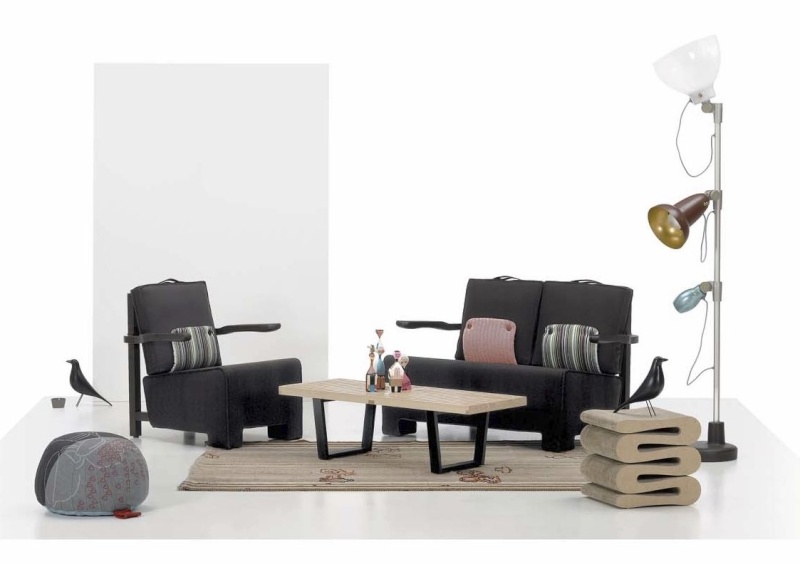George Nelson - design
Traditional Kustom Hot Rod and Vintage Culture and design :: Architects & Designers - Mid Century Modern - Vintage 50 - 70 - MCM
Page 1 sur 1
 George Nelson - design
George Nelson - design
George Nelson (1908, Hartford, Connecticut – 1986, New York) est un designer américain1. Tout comme Paul László, Charles Eames et Isamu Noguchi, il a conçu une panoplie d'objets pour la compagnie Herman Miller et a contribué à son rayonnement international.

George Nelson (1908–1986) was an American industrial designer, and one of the founders of American Modernism. While Director of Design for the Herman Miller furniture company both Nelson, and his design studio, George Nelson Associates, Inc., designed much of the 20th century's most iconic modernist furniture.

Education
George Nelson graduated from Hartford Public High school in 1924, thereafter attending Yale University. Nelson did not originally set out to become an architect. He happened upon the architecture school at Yale because of a rain storm, ducking into the building in order to get out of the rain. Walking through the building, he came upon an exhibit of students' works entitled "A Cemetery Gateway". Nelson met with some early recognition while still an undergraduate, being published in Pencil Points and Architecture magazine. He graduated with a degree in architecture in 1928. During his final year at Yale Nelson was hired by the architecture firm Adams and Prentice as a drafter.
In 1929 Nelson was hired as a Teacher's Assistant while getting his second bachelor's degree at Yale. He received a degree in Fine Arts in 1931. The next year, while preparing for the Paris Prize competition, he won the Rome Prize. The award for the Rome Prize was a year studying architecture with a healthy stipend and accommodations in a palace in Rome.
Based in Rome, Nelson traveled through Europe, where he met a number of the modernist pioneers, whom he interviewed for articles for Pencil Points magazine. While interviewing Ludwig Mies Van Der Rohe Van Der Rohe asked about Frank Lloyd Wright whom Nelson was embarrassed to say, he did not know much about. Years later he would work with Wright on a special issue of Architectural Forum which would come to be Wright's comeback from relative obscurity. While in Rome Nelson married Frances Hollister. A few years later he returned to the United States to devote himself to writing. Through his articles in Pencil Points he introduced the work of Walter Gropius, Mies van der Rohe, Le Corbusier and Gio Ponti to North America.

Architectural Forum
In 1935 Nelson joined Architectural Forum, where he was first associate editor (1935–1943), and later consulting editor (1944–1949). There he defended the modernist principles, arguing against colleagues who, as "industrial designers", made too many concessions to the commercial forces of the industry. Nelson believed that the work of a designer should be to better the world. In his view, nature was already perfect, but man ruined it by making things that didn't follow the rules of nature. "The contemporary architect, cut off from symbols, ornament and meaningful elaborations of structural form, all of which earlier periods processed in abundance, has desperately chased every functional requirement, every change in sight or ornamentation, every technical improvement, to provide some basis for starting his work. Where the limitations were most rigorous, as for example in a factory, or in a skyscraper where every inch had to yield its profit, there the designers were happiest and the results most satisfying. but, let a religious belief or a social ideal replace the cubic foot costs or radiation losses, and nothing happened. There is not a single modern church in the entire country that is comparable to a first-rate cafeteria, as far as solving the problem is concerned."[1] At this point Nelson’s career still mainly involved writing for architecture magazines, and not actually designing the solutions to modern living that he would later become famous for. During this period George Nelson spent a great deal of time interviewing and exchanging ideas with the other founders of the modernist architecture movement of the forties, including Eliot Noyes, Charles Eames, and Walter B. Ford, all of whom he would later collaborate with.
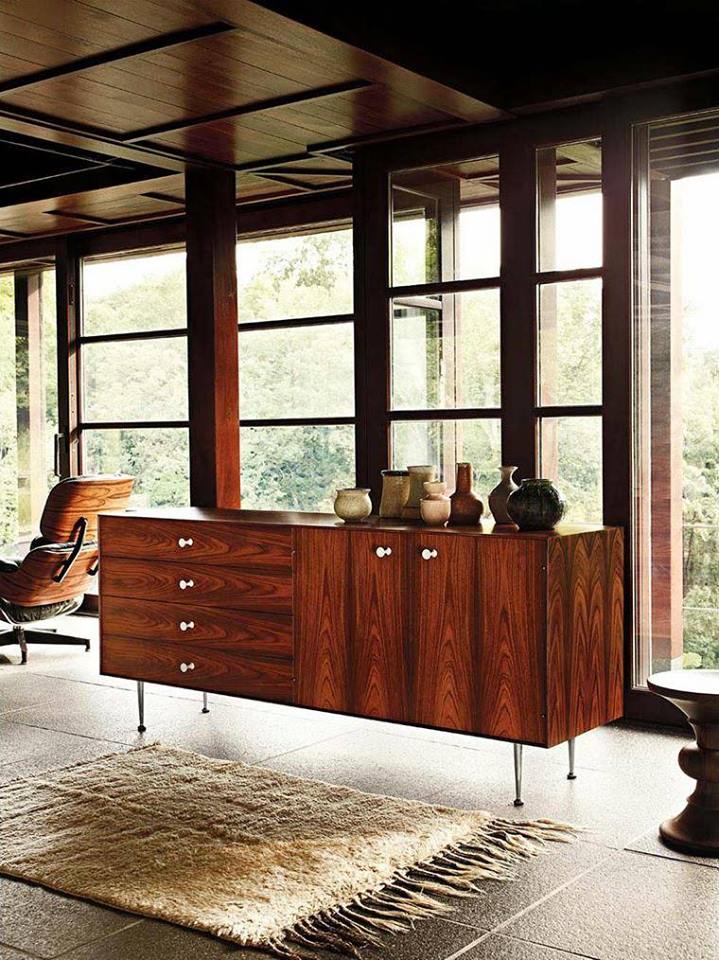
Tomorrow's House
By 1940 George Nelson had become known for several innovative concepts. In his post-war book Tomorrow's House, co-authored with Henry Wright, he introduced the concept of the "family room", and the "storage wall". The storage wall was essentially the idea of recessed, built-in bookcases or shelving occupying space previously lost between walls. It was an idea developed while writing the book, when Nelson's publisher was pressuring him to finish the section on storage. Neither Wright nor Nelson could find any new innovations when Nelson posed the question, "What's inside the wall?",[1] It was then that the idea of utilizing the space in between walls for storage was born. Tomorrow's House was innovative because it didn’t look at modern design as a case of styles, but instead looked at the way problems needed to be solved.[1]
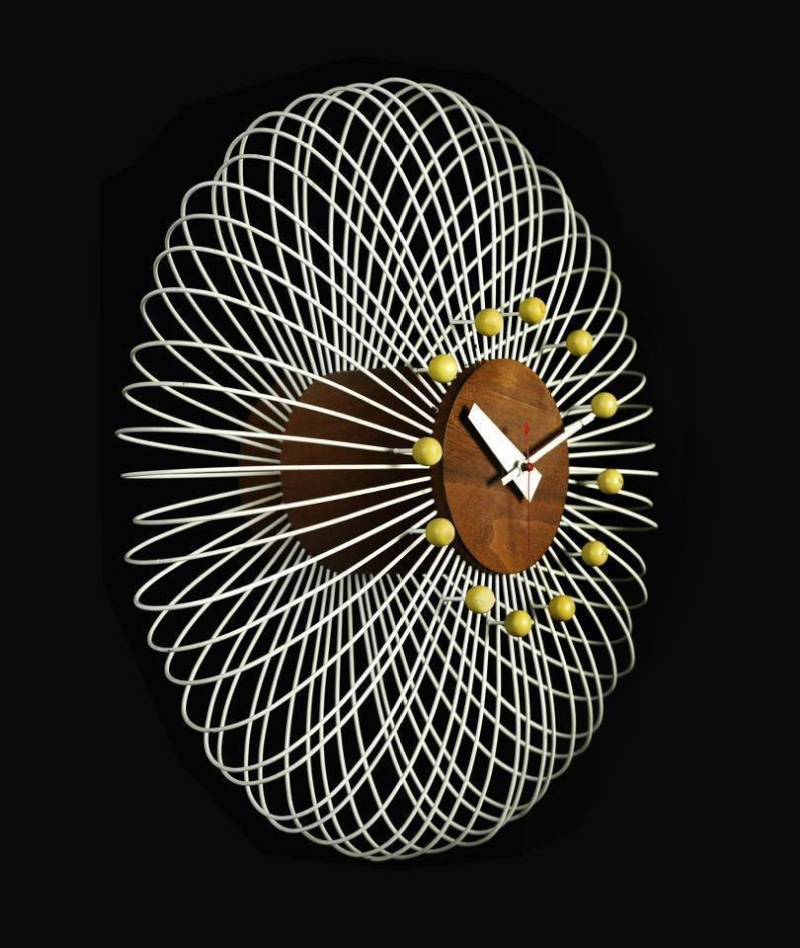
Herman Miller
In 1945, the Herman Miller furniture company was producing mostly conventional, wood-based designs. After reading Tomorrow's House D.J. Depree, the Chairman of Herman Miller, selected Nelson to be the company's next Director of Design, despite Nelson having no experience designing furniture. Depree was more interested in Nelson’s insight into the best way to make furniture innovative and useful. Nelson was offered a contract that allowed him the freedom to work outside of Herman Miller, and to use designs from other architects that Nelson had worked with. He became the Director of Design for Herman Miller in 1947, and held the position until 1972. The first Herman Miller catalog produced by Nelson was released in 1945. Over the following years it would include some of the most iconic home furnishings of the 20th century. Ray and Charles Eames, Harry Bertoia, Richard Schultz, Donald Knorr, and Isamu Noguchi all worked for Herman Miller, under Nelson's supervision. Although both Bertoia and Noguchi later expressed regrets about their involvement, it became a successful period for the company, and for George Nelson.

George Nelson Associates, Inc.
Using the money he earned as Director of Design for Herman Miller, in 1947 Nelson opened a design studio in New York City. On October 26, 1955 he incorporated it into George Nelson Associates, Inc., and moved to 251 Park Avenue South. The studio was successful in bringing together many of the top designers of the era, who were soon designing for Herman Miller under the George Nelson label. Among the noted designers who worked for George Nelson Associates, Inc. were Irving Harper, George Mulhauser (designer of the Coconut Chair), Robert Brownjohn (designer of the sets for the James Bond film Goldfinger), Don Chadwick, Bill Renwick, Suzanne Sekey, John Svezia, Ernest Farmer, Tobias O'Mara, George Tscherney, (who designed the Herman Miller advertisements), Lance Wyman, and John Pile. With his studio, Nelson enacted new practices for the involvement of design in all aspects of the company, pioneering the practice of corporate image management, graphic programs, and signage. By the time the company closed in the mid-1980s George Nelson Associates, Inc. had worked with most of the Fortune 500 companies. George Nelson's architectural projects included what he dubbed "The Colombian Garden of Health", a 200 bed tertiary care hospital in Bogota, Colombia, commisoned by the Fundacion Santa Fe de Bogota.
The office cubicle
In 1960 Herman Miller created the Herman Miller Research Corporation under the direction of Robert Propst, and the supervision of George Nelson.[2] Although Nelson remained at Herman Miller's main campus in Zeeland, Michigan, Robert Propst and the Herman Miller Research Corporation was located in Ann Arbor, Michigan[2] to place it in close proximity to the University of Michigan campus. The company's purpose was to examine changes in the use of office furniture that had taken place during the 20th century, but not the furniture itself. After consulting with experts in psychology, anthropology, and various other fields, Propst created the Action Office I line, which was executed by Nelson's studio, and first appeared in Herman Miller's 1964 catalog. For designing the Action Office I Nelson was awarded the prestigious Alcoa award. The Action Office I line was not a success, and Nelson was removed from the project. Propst then created the Action Office II, which is better known today as the "Office cubicle". Despite the "Action Office II" line becoming Herman Miller's most successful project, George Nelson disowned himself from any connection with the project.[3] In 1970 he sent a letter to Robert Blaich, who had become Herman Miller's Vice-President for Corporate Design and Communication, in which he described the system's "dehumanizing effect as a working environment." He summed up his feeling by saying:
"One does not have to be an especially perceptive critic to realize that AO II is definitely not a system which produces an environment gratifying for people in general. But it is admirable for planners looking for ways of cramming in a maximum number of bodies, for "employees" (as against individuals), for "personnel," corporate zombies, the walking dead, the silent majority. A large market."[3]
Scornful as he may have been, Nelson was right that there turned out to be a "larger market" for AO II. By 2005 total sales had reached $5 billion.[3]

George Nelson (1908–1986) was an American industrial designer, and one of the founders of American Modernism. While Director of Design for the Herman Miller furniture company both Nelson, and his design studio, George Nelson Associates, Inc., designed much of the 20th century's most iconic modernist furniture.

Education
George Nelson graduated from Hartford Public High school in 1924, thereafter attending Yale University. Nelson did not originally set out to become an architect. He happened upon the architecture school at Yale because of a rain storm, ducking into the building in order to get out of the rain. Walking through the building, he came upon an exhibit of students' works entitled "A Cemetery Gateway". Nelson met with some early recognition while still an undergraduate, being published in Pencil Points and Architecture magazine. He graduated with a degree in architecture in 1928. During his final year at Yale Nelson was hired by the architecture firm Adams and Prentice as a drafter.
In 1929 Nelson was hired as a Teacher's Assistant while getting his second bachelor's degree at Yale. He received a degree in Fine Arts in 1931. The next year, while preparing for the Paris Prize competition, he won the Rome Prize. The award for the Rome Prize was a year studying architecture with a healthy stipend and accommodations in a palace in Rome.
Based in Rome, Nelson traveled through Europe, where he met a number of the modernist pioneers, whom he interviewed for articles for Pencil Points magazine. While interviewing Ludwig Mies Van Der Rohe Van Der Rohe asked about Frank Lloyd Wright whom Nelson was embarrassed to say, he did not know much about. Years later he would work with Wright on a special issue of Architectural Forum which would come to be Wright's comeback from relative obscurity. While in Rome Nelson married Frances Hollister. A few years later he returned to the United States to devote himself to writing. Through his articles in Pencil Points he introduced the work of Walter Gropius, Mies van der Rohe, Le Corbusier and Gio Ponti to North America.

Architectural Forum
In 1935 Nelson joined Architectural Forum, where he was first associate editor (1935–1943), and later consulting editor (1944–1949). There he defended the modernist principles, arguing against colleagues who, as "industrial designers", made too many concessions to the commercial forces of the industry. Nelson believed that the work of a designer should be to better the world. In his view, nature was already perfect, but man ruined it by making things that didn't follow the rules of nature. "The contemporary architect, cut off from symbols, ornament and meaningful elaborations of structural form, all of which earlier periods processed in abundance, has desperately chased every functional requirement, every change in sight or ornamentation, every technical improvement, to provide some basis for starting his work. Where the limitations were most rigorous, as for example in a factory, or in a skyscraper where every inch had to yield its profit, there the designers were happiest and the results most satisfying. but, let a religious belief or a social ideal replace the cubic foot costs or radiation losses, and nothing happened. There is not a single modern church in the entire country that is comparable to a first-rate cafeteria, as far as solving the problem is concerned."[1] At this point Nelson’s career still mainly involved writing for architecture magazines, and not actually designing the solutions to modern living that he would later become famous for. During this period George Nelson spent a great deal of time interviewing and exchanging ideas with the other founders of the modernist architecture movement of the forties, including Eliot Noyes, Charles Eames, and Walter B. Ford, all of whom he would later collaborate with.

Tomorrow's House
By 1940 George Nelson had become known for several innovative concepts. In his post-war book Tomorrow's House, co-authored with Henry Wright, he introduced the concept of the "family room", and the "storage wall". The storage wall was essentially the idea of recessed, built-in bookcases or shelving occupying space previously lost between walls. It was an idea developed while writing the book, when Nelson's publisher was pressuring him to finish the section on storage. Neither Wright nor Nelson could find any new innovations when Nelson posed the question, "What's inside the wall?",[1] It was then that the idea of utilizing the space in between walls for storage was born. Tomorrow's House was innovative because it didn’t look at modern design as a case of styles, but instead looked at the way problems needed to be solved.[1]

Herman Miller
In 1945, the Herman Miller furniture company was producing mostly conventional, wood-based designs. After reading Tomorrow's House D.J. Depree, the Chairman of Herman Miller, selected Nelson to be the company's next Director of Design, despite Nelson having no experience designing furniture. Depree was more interested in Nelson’s insight into the best way to make furniture innovative and useful. Nelson was offered a contract that allowed him the freedom to work outside of Herman Miller, and to use designs from other architects that Nelson had worked with. He became the Director of Design for Herman Miller in 1947, and held the position until 1972. The first Herman Miller catalog produced by Nelson was released in 1945. Over the following years it would include some of the most iconic home furnishings of the 20th century. Ray and Charles Eames, Harry Bertoia, Richard Schultz, Donald Knorr, and Isamu Noguchi all worked for Herman Miller, under Nelson's supervision. Although both Bertoia and Noguchi later expressed regrets about their involvement, it became a successful period for the company, and for George Nelson.

George Nelson Associates, Inc.
Using the money he earned as Director of Design for Herman Miller, in 1947 Nelson opened a design studio in New York City. On October 26, 1955 he incorporated it into George Nelson Associates, Inc., and moved to 251 Park Avenue South. The studio was successful in bringing together many of the top designers of the era, who were soon designing for Herman Miller under the George Nelson label. Among the noted designers who worked for George Nelson Associates, Inc. were Irving Harper, George Mulhauser (designer of the Coconut Chair), Robert Brownjohn (designer of the sets for the James Bond film Goldfinger), Don Chadwick, Bill Renwick, Suzanne Sekey, John Svezia, Ernest Farmer, Tobias O'Mara, George Tscherney, (who designed the Herman Miller advertisements), Lance Wyman, and John Pile. With his studio, Nelson enacted new practices for the involvement of design in all aspects of the company, pioneering the practice of corporate image management, graphic programs, and signage. By the time the company closed in the mid-1980s George Nelson Associates, Inc. had worked with most of the Fortune 500 companies. George Nelson's architectural projects included what he dubbed "The Colombian Garden of Health", a 200 bed tertiary care hospital in Bogota, Colombia, commisoned by the Fundacion Santa Fe de Bogota.
The office cubicle
In 1960 Herman Miller created the Herman Miller Research Corporation under the direction of Robert Propst, and the supervision of George Nelson.[2] Although Nelson remained at Herman Miller's main campus in Zeeland, Michigan, Robert Propst and the Herman Miller Research Corporation was located in Ann Arbor, Michigan[2] to place it in close proximity to the University of Michigan campus. The company's purpose was to examine changes in the use of office furniture that had taken place during the 20th century, but not the furniture itself. After consulting with experts in psychology, anthropology, and various other fields, Propst created the Action Office I line, which was executed by Nelson's studio, and first appeared in Herman Miller's 1964 catalog. For designing the Action Office I Nelson was awarded the prestigious Alcoa award. The Action Office I line was not a success, and Nelson was removed from the project. Propst then created the Action Office II, which is better known today as the "Office cubicle". Despite the "Action Office II" line becoming Herman Miller's most successful project, George Nelson disowned himself from any connection with the project.[3] In 1970 he sent a letter to Robert Blaich, who had become Herman Miller's Vice-President for Corporate Design and Communication, in which he described the system's "dehumanizing effect as a working environment." He summed up his feeling by saying:
"One does not have to be an especially perceptive critic to realize that AO II is definitely not a system which produces an environment gratifying for people in general. But it is admirable for planners looking for ways of cramming in a maximum number of bodies, for "employees" (as against individuals), for "personnel," corporate zombies, the walking dead, the silent majority. A large market."[3]
Scornful as he may have been, Nelson was right that there turned out to be a "larger market" for AO II. By 2005 total sales had reached $5 billion.[3]
_________________
We don't care the People Says , Rock 'n' roll is here to stay - Danny & the Juniors - 1958
 Re: George Nelson - design
Re: George Nelson - design
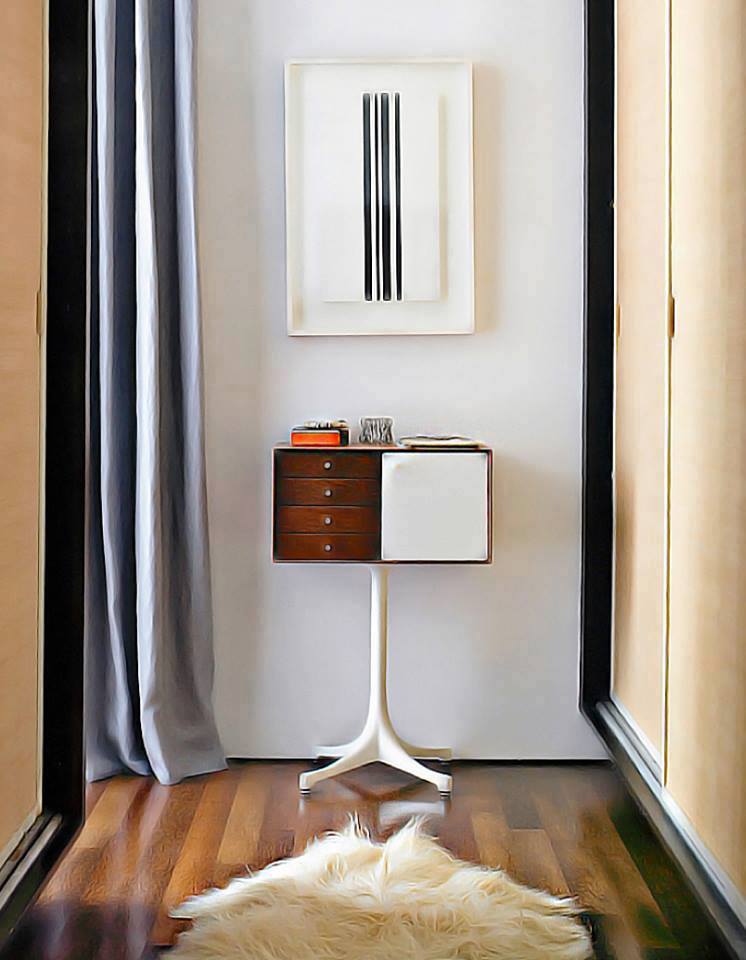
Influence
The George Nelson Associates, Inc. catalog, and exhibition designs for Herman Miller, made modernism the most important driving force in the company. From his start in the mid-forties until the mid-eighties George Nelson Associates, Inc. partnered with most of the modernist designers of the time. This was both the result of Nelson’s time as a magazine editor, and because of Nelson's writing. His skill as a writer helped legitimize and stimulate the field of industrial design by contributing to the creation of Industrial Design magazine in 1953.[1] Nelson wrote extensively, published several books, and organized conferences like the Aspen design gatherings, where for more than 30 years he was the guiding force.[1] In 1971, he received a grant from the Graham Foundation for his project "Hidden Cities". One of George Nelson's areas of interest was the reduction of pollution. Through his attempts to reduce all forms of pollution, including visual, audio, and chemical, Nelson pioneered the idea of the outdoor shopping mall, first using the idea in a proposal for the city plan of Austin, Texas, which was not used.
George Nelson retired with the closing of his studio in the mid-1980s. He died in New York City in 1986.

Controversy
In recent years it has become known that many of the designs George Nelson accepted credit for were actually the work of other designers employed at his studios.[4] Examples of this include the Marshmallow sofa, which was actually designed by Irving Harper,[4] and the Action Office, for which Nelson won the prestigious Alcoa Award, neglecting to mention that it was largely designed by Robert Propst.[2] John Pile, a designer who worked for Nelson in the 1950s, commented about this practice; "George's attitude was that it was okay for individual designers to be given credit in trade publications, but for the consumer world, the credit should always be to the firm, not the individual. He didn't always follow through on that policy though."[5]
In an interview in Metropolis in 2001, Irving Harper also commented on this practice: "...there always had to be one name associated with the work. We couldn't just spread it around… that's fine. I'm grateful to George for what he did for me. While he was alive, I made no demands whatsoever, but now that he's gone, whenever the Marshmallow Sofa is referred to as a 'George Nelson design', it sort of gets to me. I don't go out of my way to set things right, but if anybody asks me who designed it, I'm perfectly happy to tell them."[6]
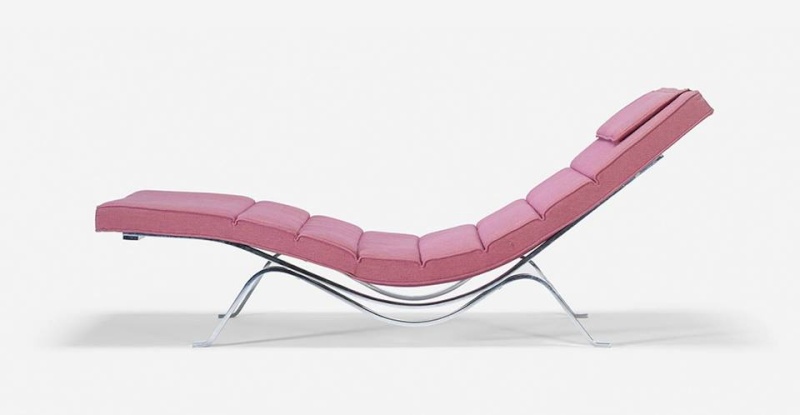
(# currently available from Herman Miller)
1946 Slat Bench a/k/a Platform Bench #
1946 Basic Cabinet Series (# a number of these cabinets were reintroduced by Herman Miller in 2011)
1946 Sofas, chairs, settees, and bedroom pieces (all included in the first Herman Miller catalog)
1947 Bubble Lamp
1950 Ball clock (likely designed by Irving Harper, originally made by Howard Miller Clock Company, reintroduced by Vitra)
1952 Rosewood Group
1952 Executive Office Group
1954 Miniature Cases #
1954 Steel-frame Group
1954 Nelson End Table (and low coffee table) #
1955 Flying Duck Chair
1955 Coconut Chair # (currently available in black leather only, but not with the matching ottoman)
1956 Thin Edge Cases (# a number of these cabinets were reintroduced by Herman Miller in 2012)
1956 Kangaroo Chair
1958 Swagged-Leg (a/k/a/ Swag Leg) Group (# reintroduced by Herman Miller in 2011)
1959 Comprehensive Storage System (CSS)
1963 Catenary Group
1964 Action Office I (principally designed by Robert Propst)
1964 Sling Sofa & coffee table

His firm, George Nelson Associates, also designed a large series of wall and table clocks for the Howard Miller company, as well as a range of hanging Bubble Lamps, which had plastic membrane-covered wire-form shades (also for Howard Miller, but currently available from Modernica (http://www.modernica.net), wrought iron fireplace pieces, planters, room dividers, ceiling-mounted "Ribbon Wall," spice cabinets, and many other products that became milestones in the history of a profession that he helped to shape.
A number of the nearly 300 classic wall clocks for Howard Miller Clock Company (including the Ball, Kite, Eye, Turbine, Spindle, Petal and Spike clocks, as well as a handful of desk clocks) are currently available from Vitra. Most were designed by Irving Harper. Subsequently, Vitra has discontinued some of the clocks based on sales.
All the original clock designs were simply assigned numbers by Howard Miller. Probably the most recognisable of the series, the Ball Clock, was advertised and sold as ‘Clock 4755’; the Sunflower Clock as ‘Clock 2261’. Several colour variations were available for many of the clocks. The Ball Clock was available in six colour variations, the Sunflower Clock in three. One of the more unusual designs, the Eye Clock (‘Clock 2238’) was pictured in the original Howard Miller Clock Company brochures in a diagonal position, not horizontal, as would be expected.
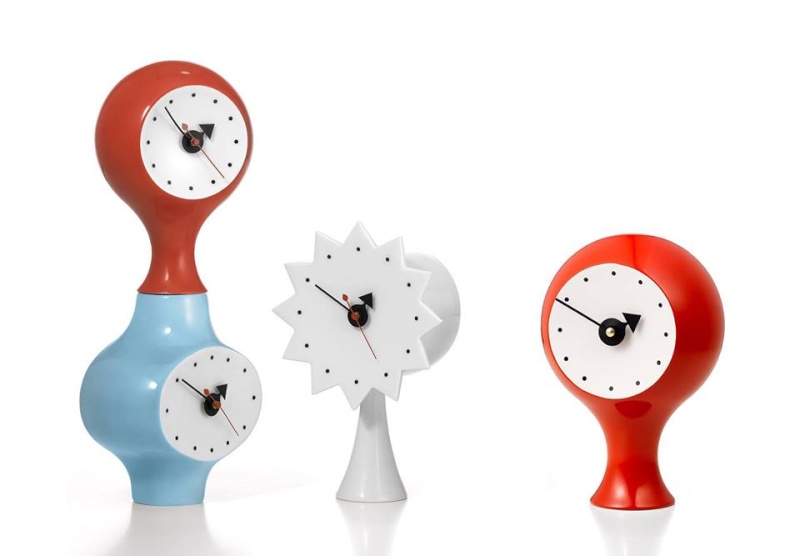
_________________
We don't care the People Says , Rock 'n' roll is here to stay - Danny & the Juniors - 1958
 Re: George Nelson - design
Re: George Nelson - design
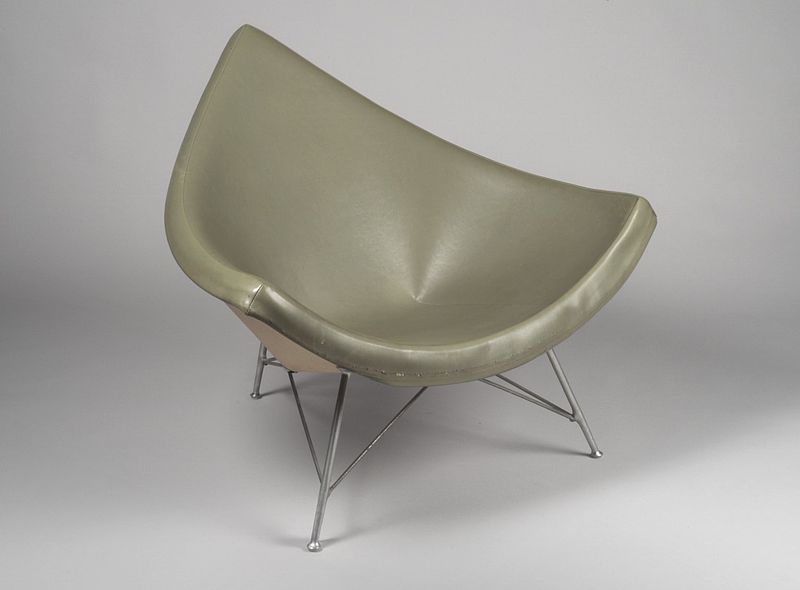
George Nelson (American, 1908-1986). "Coconut" Chair, 1958. Fiberglass, leather, aluminum, 34 1/4 x 40 3/4 x 34 in. (87 x 103.5 x 86.4 cm). Brooklyn Museum, Bequest of Mrs. Carl L. Selden, 1996.142.42
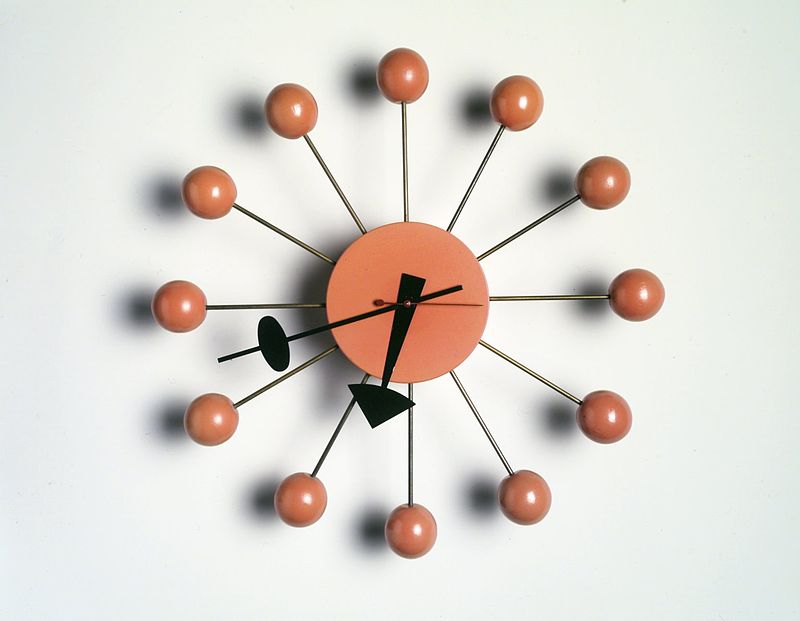
Irving Harper (American, 20th century). "Ball" Wall Clock, 1948-1969. Painted birch, steel, brass, 13 1/2 x 13 1/2 x 2 3/4 in. (34.3 x 34.3 x 7 cm). Brooklyn Museum, H. Randolph Lever Fund, 2000.101.1
_________________
We don't care the People Says , Rock 'n' roll is here to stay - Danny & the Juniors - 1958
 Re: George Nelson - design
Re: George Nelson - design

George Nelson, né en 1908 à Hartford, Connecticut, USA étudie l’architecture à l’Université de Yale. Une bourse lui permet d'étudier de 1932 à 1934 à l’Académie américaine à Rome. Lors de son séjour en Europe, il découvre les édifices et les protagonistes de l’art moderne.
En 1935, il entre à la rédaction de l’«Architectural Forum» dont il fait partie jusqu’en 1944. En 1944 il y publie un article manifeste sur la construction d’habitations et le design mobilier qui attire l’attention de D.J. DePree, le chef de l’entreprise de mobilier Herman Miller.
Peu de temps après, George Nelson est nommé directeur du design chez Herman Miller. Il conserve ce poste jusqu'en 1972 et devient un personnage-clé du design américain: il fait appel à Charles & Ray Eames, Isamu Noguchi et Alexander Girard pour Herman Miller.
La collaboration avec Vitra commence en 1957. Parallèlement il dirige sa propre agence de design depuis 1946 et crée quelques objets qui sont considérés comme des icônes du «Mid-Century-Modern».
L’agence de Nelson se consacre également à l’architecture et à la scénographie d’expositions. George Nelson meurt à New York en 1986. Ses archives sont conservées par le Vitra Design Museum.
https://www.vitra.com/fr-be/corporation/designer/details/george-nelson
_________________
We don't care the People Says , Rock 'n' roll is here to stay - Danny & the Juniors - 1958
 Marshmallow Sofa George Nelson, 1956
Marshmallow Sofa George Nelson, 1956
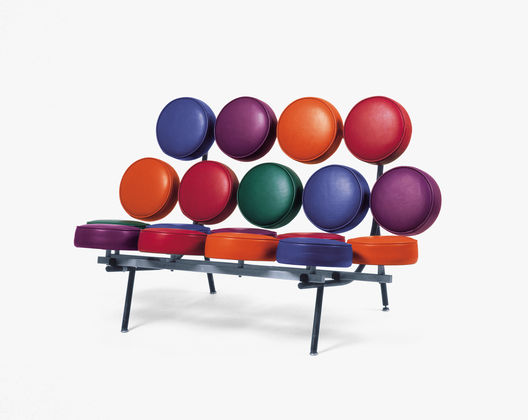
Cette création de Nelson transforme le canapé traditionnel en un jeu de 18 coussins multicolores portés par une structure en acier. Ses lignes et sa structure inhabituelles font du Marshmallow Sofa un canapé exceptionnel dans l’histoire du design.

Un élément de liaison composé de 6 coussins individuels peut être monté entre deux canapés, qui peuvent ainsi être agrandis à volonté. Les coussins du canapé individuels sont recouverts d'une housse en vinyle robuste.
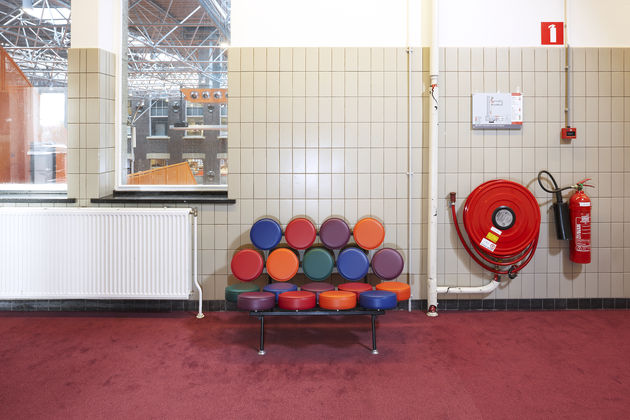
_________________
We don't care the People Says , Rock 'n' roll is here to stay - Danny & the Juniors - 1958
 Sunburst clock
Sunburst clock
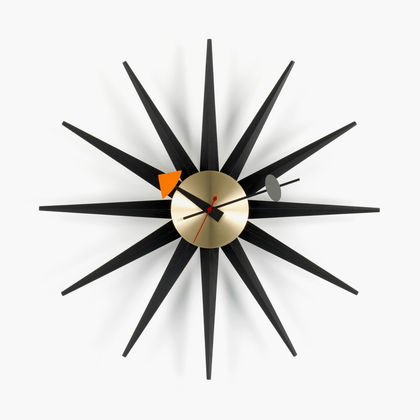
La croyance dans le progrès et la prospérité économique croissante sont des aspects centraux de l'« American way of life » dans les années 1950. Tout semblait possible, et les gens s'efforçaient d'être « modernes ». Dans le but d'apporter un design moderne dans les foyers américains, George Nelson a conçu une vaste gamme d'objets du quotidien : lampes, horloges et autres accessoires domestiques. Jusque dans les années 1970, Nelson a créé de nombreux éléments différents pour la maison, y compris les « Bubble Lamps » et la « Ball Clock », qui sont devenus des icônes du design moderne du milieu du siècle.
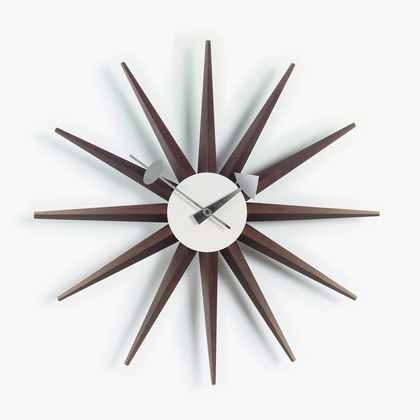
Les Wall Clocks sont disponibles dans différentes formes et matériaux. Équipées d'un mécanisme à quartz de haute précision, elles constituent une alternative pleine de fraîcheur aux horloges habituelles. Le grand choix de créations comporte le modèle parfait pour chaque occasion.

_________________
We don't care the People Says , Rock 'n' roll is here to stay - Danny & the Juniors - 1958
 Re: George Nelson - design
Re: George Nelson - design
_________________
We don't care the People Says , Rock 'n' roll is here to stay - Danny & the Juniors - 1958
 Sujets similaires
Sujets similaires» 1967 Oldsmobile Toronado - "Mannix Roadster" by George Barris Kustom City - Built by George Barris for the TV show "Mannix"
» Ricky Nelson - I Can't Help It
» Ricky Nelson - That's All
» Ricky Nelson - Just A Little Too Much
» Ricky Nelson - It's Up To You
» Ricky Nelson - I Can't Help It
» Ricky Nelson - That's All
» Ricky Nelson - Just A Little Too Much
» Ricky Nelson - It's Up To You
Traditional Kustom Hot Rod and Vintage Culture and design :: Architects & Designers - Mid Century Modern - Vintage 50 - 70 - MCM
Page 1 sur 1
Permission de ce forum:
Vous ne pouvez pas répondre aux sujets dans ce forum
 Connexion
Connexion
